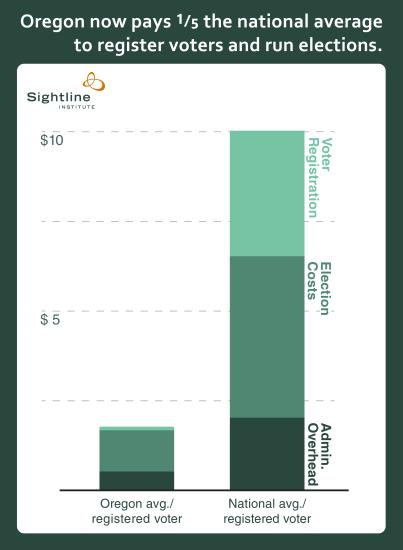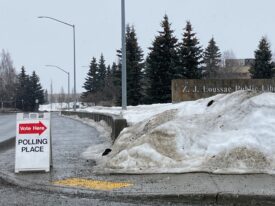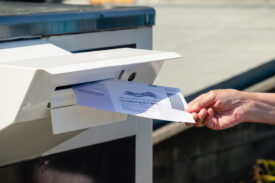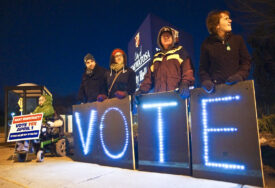There is a war going on, and Oregon is ground zero. Some states, mostly in the South and Midwest, are restricting voter rights through Voter ID laws and barriers to voter registration. But the Pacific Northwest is defending rights. In a democracy, honoring every citizen’s vote is the right thing to do. Oregon proves it is also the cost-conscious thing to do.
Oregon is a national leader in striking down the barriers to voting: the Beaver State enables citizens to register online, mails ballots to all registered voters, and now will digitally transfer eligible voters’ information from the Department of Motor Vehicles (DMV) to the voter rolls. But even in Oregon, every single Republican and one Democrat voted against the new motor voter law. House Republican Leader Carl Wilson of Grants Pass explained that the law would “cost a broke county $7,800 in the first year. That is money we don’t have.” Never mind that the cost of honoring Josephine County’s citizens’ right to vote adds an infinitesimal 0.009 percent to the county’s $84 million budget.
If this war were really about how much money states and counties spend on voting, voting rights would be winning across the country. For all its efforts to empower voters, Oregon gets a real bargain on elections. Other states could too.

Original Sightline Institute graphic, available under our free use policy.
Honoring citizens’ right to vote by running the state and county administrations that register voters; keeping the voter rolls updated and accurate; distributing, collecting, and tallying ballots—add up the costs of all those activities and divide by the number of registered voters in Oregon, and it comes to less than $2 per registered voter per election.
Other states average around $10 per registered voter per election.
By erecting or maintaining barriers to voting, other states pay five times as much as Oregon.
Why are Oregon’s costs so much lower than the national average?
1. It’s expensive to suppress voters.
Some states are paying $3–5 per registered voter to enforce Voter ID laws aimed at stopping people showing up at the polls pretending to be somebody else in order to cast one fake vote. Problem is, that almost never happens.
Investigators found that, out of more than one billion votes cast in general, primary, special, and municipal elections in the United States from 2000 through 2014, there were only 31 credible cases of voter fraud. More people get hit by lightning than commit voter fraud. More people escape from maximum-security prisons than perpetuate voter fraud. Because… why would you? For one extra vote, out of however many thousands or millions or hundreds of millions of votes are cast in that election, you risk five years in prison, a $10,000 fine, and other penalties.FACT: More people get hit by lightning than commit voter fraud.
Most voting glitches arise not from people trying to defraud election officials, but from errors in the voting roll. Clerks typing in information from handwritten paper registration forms sometimes make mistakes; voters sometimes don’t fill out the forms completely; people stay on the voter rolls after they are dead. Throwing sand in the gears of the democratic process with expensive Voter ID requirements doesn’t solve these problems. Utilizing technology to maintain clean and accurate voter rolls does. States interested in cost-effectively cleaning their voter rolls can do what Oregon, Washington, and six other states have done: join the Electronic Registration Information Center. Oregon joined in 2014 and the system has helped electronically clean the state’s voter rolls by identifying voters who move to another county or another state, flagging duplicate entries, and removing voters from the rolls when they die.
States can choose a path: spend hundreds of millions of dollars to protect against an almost-non-existent crime, while effectively suppressing hundreds of thousands of voters, particularly minority voters; or, do like Oregon. Save 80 percent on election expenses by maintaining accurate, electronic voter rolls, automatically electronically registering all eligible voters, and mailing them a ballot.
2. Honoring more voters reduces fixed costs per voter.
Printing and mailing ballots are variable costs—the more ballots, the more counties pay in printing and postage—but some election activities are fixed costs. Maintaining the elections office and paying regular staff, owning the machines that count the votes— these outlays don’t change even if more ballots come in. Oregon’s new motor voter law will expand the pool of voters, driving down the expense per voter.
That said, because variable costs will increase, more registered voters mean Oregon counties will pay more per election. Multnomah, Oregon’s largest county with around half a million voters, will pay about $40,000 more per election. Josephine County, with 50,000 voters, will pay about $7,800 more per year. Counties estimate they pay about 15¢ more per registered voter per year to send out and count more ballots as a result of the new motor voter law adding voters to the rolls. However, even that modest amount may be an overestimate; in calculating that number, counties added up their estimated expenditures on elections, but did not subtract the savings from avoided paper registrations.
3. Digital registration is convenient for voters and inexpensive for counties.
Voters don’t want to slog through paperwork to register to vote, and county budgets don’t like it either. It’s time-consuming and therefore expensive to process paper voter registrations. Someone has to cut the paper down to size, batch it for processing, scan it, check for duplicate registrations, type the information in, and verify it. In 2008, when voter registration was by paper form only, Oregon spent $4.11 per registered voter to add new voters and maintain the voter list.
Although Oregon now allows online digital registration, most new registrations are still on paper. New registrations come from the DMV, where registrants fill out a form, or from voter registration drives, where someone stands outside your grocery store and gives you a form to fill out.#Oregon now pays 1/5 the national average to register voters, run elections.
Digital registration is 10 to 30 times faster (and cheaper) than paper. Maricopa County, Arizona, pays about 83¢ to process a paper registration, but only 3¢ for a digital registration. Multnomah County estimates that it pays about $2 per paper form and 20¢ or less per digital transaction to register a new voter.
With Oregon’s new motor voter law, the DMV will digitally transfer voter information to the voter rolls, rather than making people fill out paper forms. Seamless digital transfer of registration information means close to 100 percent of registrations will be digital, saving Oregon counties 90 percent or more of the cost to register new voters.
4. Vote-by-mail is easier for voters and easy on the budget.
Some election costs are the same no matter where you are: all counties must print and count ballots. But states that use polling places incur additional costs: buying and maintaining voting machines, renting the voting space, paying temporary poll workers, and paying poll judges. Oregon avoids all of these budget lines with vote-by-mail. The data are spotty, but experience in Oregon, Nebraska, and California suggests vote-by-mail saves counties 20-70 percent of Election Day costs.
These savings will continue to increase over time as labor and voting machine costs rise. Temporary labor is the main driver of polling place price tags, and labor costs are going up, meaning Oregon saves its taxpayers more money every year by not employing temporary workers. Voting machines are also getting pricier. The machines carry sticker prices around $4,000. The federal government subsidized the purchase of many county voting machines in the early 2000s, but those initial costs are generally only a small portion of their life-span outlays; counties must now pay to store, maintain, and operate the machines. Also, those machines will eventually need to be replaced.
Conducting elections by mail removes an important barrier for voters—getting to a polling place, on a work day, and maybe waiting in line, maybe in inclement weather— and saves the state money to boot.
If you ever hear your representative claim that protecting citizens’ right to vote, while a nice gesture, is just too darned expensive, you can tell them this: maintaining modern, accurate voter rolls, registering every eligible citizen to vote, and mailing every voter a ballot will not only bring your state closer to our national democratic ideals, it will save gobs of money compared to making voters jump through hoop after hoop to exercise their rights. Less hoops, lower expenses, more voting.
Appendix
Hard facts on election costs are surprisingly difficult to find. Oregon is the only state that publishes what election administrators spent on voting in every election, going back to 1992. (Colorado now releases some statewide data, too). Costs vary a lot between counties (smaller counties spend more per voter, because they have fewer voters) and between elections (the 2008 election was pricier than average). The numbers in the chart and table above are estimates of average costs per registered voter. These costs are not per transaction—not the cost of adding one more voter to the rolls or mailing and counting one additional ballot—but the average outlay for all registered voters. I used two main sources of information for these estimates:
- A national survey of election costs conducted in 2000 estimated total costs of voter registration plus elections to average $10 ($13.57 in today’s dollars). Of that, $3.50 was for voter registration and $6.50 was for elections. Some counties pay as much as $30 per registered voter to run their elections.
- A Colorado statewide study found 2010 elections costs (excluding the cost of voter registration) of $6.70 per registered voter.
I compared these numbers with other sources:
- A 2004 survey of all counties in Florida revealed an average election cost (excluding voter registration) of about $11 per registered voter.
- California’s Marin County estimated election costs (without registration) of $1.75-10.00 per registered voter.
- Minnesota estimates that early voting costs $3.08 per vote cast, and processing absentee ballots costs $7.28 per absentee ballot cast.
- A 2010 study by the Indiana Fiscal Policy Institute estimated election costs at around $3 per registered voter.
- A 2008 study showing that voter registration cost Oregon $4.11 per registered voter ($7.67 per new voter registered or voter registration record updated).
Based on these numbers, in the chart and table above I estimated national costs as $3.50 per registered voter for registration and $6.50 for election costs. By comparison, Oregon’s elections historically cost around $1.50 per registered voter. Oregon’s new motor voter law will add 15¢ per registered voter to election costs. Registration expenditures now have two components: 1) digitally registering new voters will cost less than a quarter per new registration, and 2) the Secretary of State will pay about fourteen cents each to mail a postcard to each new registrant. Dividing the costs for the newbies by the number of all registered voter adds up to an average voter registration cost of about 10¢ per registered voter.









Lloyd Hargrove
Unless we can definitively identify one vote for each real and well documented U.S., State and Local qualified citizen there is NO true representative government. There is no excuse, none in this day and age for a legal U.S. citizen/legal voter to not have proper identification at the polls as well as previously existing voter registration at their own local voting places under the careful watch their own local authorities and multi-party poll watchers charged with operating same.
Citizenship, nor even day to day life exists in a vacuum and proper I.D’s are required for practically everything one does, period. Absentee voting notwithstanding, the same assistance offered by politically oriented organizations in getting any (presumed incapable)legal voters physically to the polls can certainly work to get them fully qualified well beforehand.
Any lack of required full identification for each voting citizen is simply a mechanism to facilitate election fraud resulting in things like 110% voter turnout and the most cunning, ruthless and totally corrupt crooks running our government. Is that really what we want?
Fbfree
I don’t understand how 110% voter turnout can happen unless the voter registration rolls are wrong.
When I was an election worker in BC, we only handed out a ballot if someone was on the voter registration. There was no way we’d let someone through twice as long as the registration was accurate. If someone didn’t have ID or an addressed envelope, we’d fill a provisional ballot for them with their signature, to be verified and counted if needed.
JBnNC
It doesn’t happen. Funny how people who don’t trust government want voters to be “under careful watch”. The only way they can explain being completely out of touch is to pretend the real world does not exist, and therefore their losses must be the result of fraud.
Kristin Eberhard
Lloyd – if what you want is to make sure that we aren’t electing corrupt people, then surely you support making sure more citizens can vote? More real people voting can dilute the power of special interests on elections.
As to your concerns about voter fraud: there are no cases of 110% voter turnout in the United States, ever, because it would be impossible.
110% turnout would mean all the registered voters voted AND a bunch of other people who weren’t on the voter rolls somehow voted. That doesn’t happen, and it isn’t what Voter ID laws are about. Voter ID laws purport to protect against people illegally pretending to be another person who is on the voter rolls, thereby stealing that citizen’s vote. This wouldn’t lead to 110% turnout; it would mean some legal citizens would not get to vote because someone else had impersonated them at the polls. This almost never happens. Your 110% comment suggests you think sometimes 10% of votes are fraudulent, which would mean millions of cases of fraud in the past 14 years, but investigators have only found 31. Thirty one instances out of over a billion votes cast. Voter fraud is less likely than getting struck by lightning.
If you are really worried about that 0.00000003% chance of voter fraud, the best thing to do is to keep the voter rolls clean so, for example, there aren’t dead people on the rolls that other people could impersonate.
Keeping voter rolls clean is more effective at preventing any possible fraud, and much much cheaper for taxpayers than expensive voter ID laws.
Rashad
Great post. Thank you!